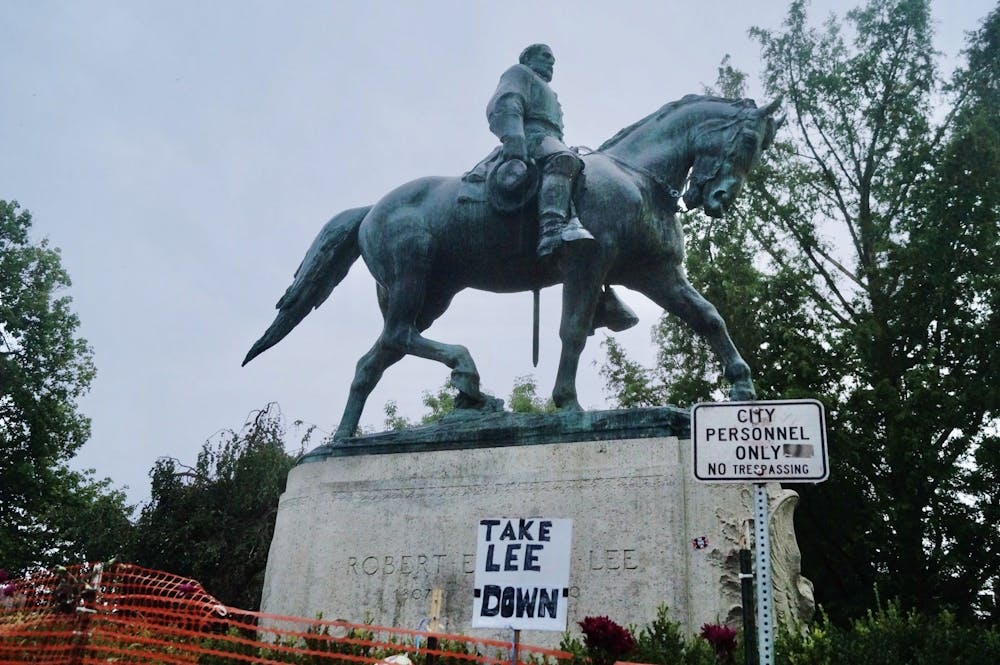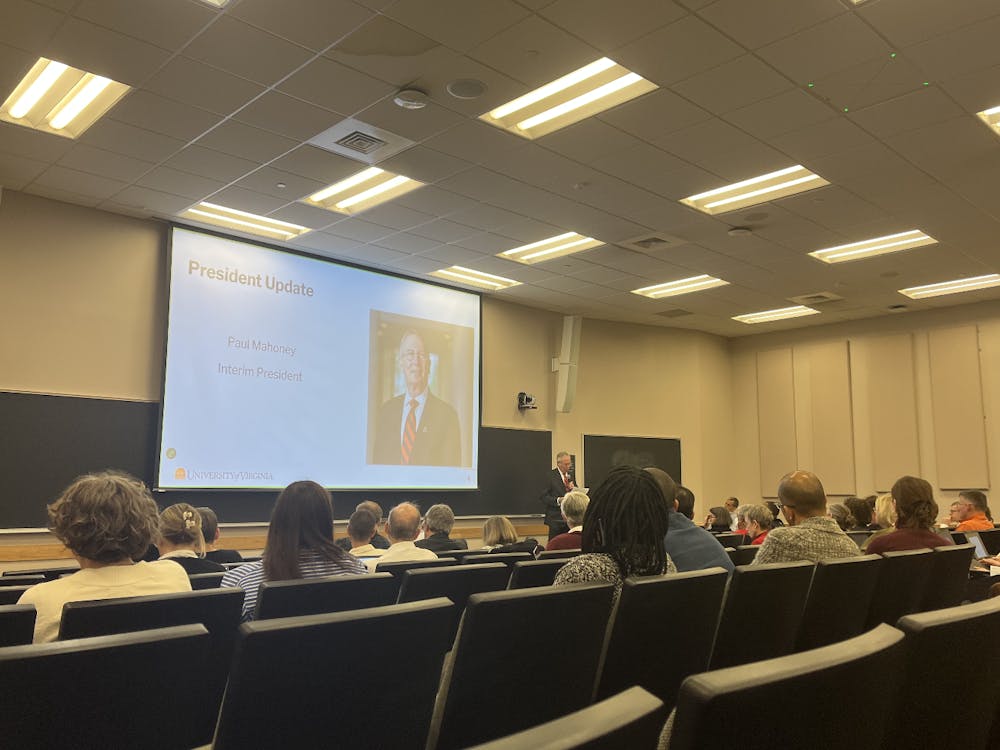Former members of the Blue Ribbon Commission on Race, Memorials and Public Spaces are calling on the Charlottesville City Council to immediately cover the statues of Robert E. Lee and Stonewall Jackson. The statement’s signees include former Chair Don Gathers, former Commissioner John Edwin Mason, Melvin Burruss, Andrea Douglas, Frank Dukes, Susan Lewis, Rachel Lloyd and Jane Smith.
Former members of the Commission released the statement last Sunday. The statement describes the symbolism associated with the Lee and Jackson statues and the Commission’s past decisions before concluding that the statues must be covered and removed.
“The statues embody ideologies of white supremacy and are rallying points for those who embrace violence and hatred,” the statement read. “They have no legitimate place in the public sphere.”
Established by the Charlottesville City Council in May 2016, the Commission was created after City Councillors Kristin Szakos and Wes Bellamy brought the idea to then Mayor Mike Signer. The Commission is charged with the responsibility of “telling the full story of Charlottesville’s history of race” and “changing the city’s narratives through our public spaces.”
The Commission — which includes subcommittees on public engagement, case studies, inventory of historical sites and historical context and background — uses input from the public to decide whether local Confederate monuments should be relocated or changed.
In November 2016, a majority of the Commission’s members voted to recommend that the statues of Robert E. Lee and Stonewall Jackson remain in their current places in Market Street Park and Court Square Park, respectively.
The Stonewall Jackson statue depicts Jackson and his horse on a marble pedestal. Paul Goodloe McIntire — a graduate of the University whose donations funded the McIntire School of Commerce, McIntire Department of Art, McIntire Amphitheatre and four local parks — dedicated the park to the city of Charlottesville on the condition that it had to include the statue of Jackson. The $35,000 statue was unveiled on October 19, 1921 during a Confederate reunion. Jackson’s great-great-granddaughter Anna Jackson Preston attended the unveiling herself.
The Robert E. Lee monument is a bronze statue that shows Lee sitting atop his horse Traveller. The statue was also commissioned by Paul Goodloe McIntire in 1917 as a gift to the city of Charlottesville. It was unveiled on May 21, 1924 as the Virginia divisions of the United Confederate Veterans and the Sons of Confederate Veterans held their annual reunions.
In March 2016, second-year College student Zyahna Bryant — then a high school student — petitioned the City Council to remove the statue of Lee and change the name of Lee Park.
“When I think of Robert E. Lee I instantly think of someone fighting in favor of slavery,” the petition read. “There is more to Charlottesville than just the memories of Confederate fighters.”
Following extensive research and public hearings, the Blue Ribbon Commission issued a report regarding the statues in December 2016. The Commission advised the City Council that the statues symbolized white supremacy and also embodied the Lost Cause interpretation of the Civil War.
The Lost Cause is an interpretation of the Civil War that encompasses nostalgia for the Confederate past as well as disregard for the atrocities of slavery. According to the Commission, the Lost Cause interpretation was “a key element in the ideological justification of the disenfranchisement of African American voters and the segregation of African Americans in virtually all walks of life, including employment, education, housing, healthcare and public accommodations.”
Disappointed with the original recommendation from November to leave the statues in place, Gathers reconvened the Commission for a second vote. In the resulting December 2016 report, the Commission reversed its previous decision and recommended that the Lee statue should either be moved to a more isolated location or altered to provide historical context. The Commission remained open to the possibility of leaving the Jackson statue in its place.
Still, the Commission recognized the shortcomings of both options in 2016.
“Relocating the statues might simply shift the interpretive and symbolic problems associated with them from one public space to another,” the recent statement reads. “Minimal or poorly-executed new designs and interpretations for the statues would fail to negate the myths and hatred that they symbolize.”
The group also voted unanimously to rename Lee Park to Emancipation Park and issued several other recommendations to City Council, including adding a new plaque and memorial on the site of a former slave auction block in Court Square, preservation efforts for the Daughters of Zion Cemetery, funding for the proposed Vinegar Hill Park and sculpture, enhancements to the Drewary Brown Bridge and historical resource surveys of local Africa American and Native American neighborhoods. The city has yet to raise enough money to build the sculpture for Vinegar Hill.
In February 2017, the City Council voted to remove the Lee statue from the park. Opponents of the decision immediately filed suit, claiming that state law prevented the city from removing the statue.
In August 2017, white supremacist Jason Kessler organized the Unite the Right Rally in Charlottesville, and the potential removal of the Lee statue and the renaming of Lee Park were key points in the bloody rally that left activist snd Charlottesville resident Heather Heyer dead alongside two others. According to the recent statement, the Commission believes that the statues continue to serve as “rallying points for those who espouse racism and anti-Semitism.”
In their latest statement, the former Commission members explained that Heyer’s murder has added yet another layer of symbolism to the statues. As a result, the former Commission members believe that re-contextualization of Confederate statues and memorials is nearly impossible.
Recent legislation, as well as a decision by the Supreme Court of Virginia, has made permanent elimination of the statues a possibility. In an opinion issued April 1, the Virginia Supreme Court ruled that the statues of Lee and Stonewall were not subject to a state law preventing their removal. The Court found that the 1997 law does not protect monuments or statues erected before its passage and therefore does not protect the 1920’s-era statues of Lee and Jackson.
Ultimately, the City Council has the “sole authority to determine the final disposition” of the statues.
In response to the Court’s decision, the Charlottesville City Council met May 3 to discuss their plans regarding the statues. According to City Manager Chip Boyles, the City Council plans to publish a notice of its intention to remove, relocate, contextualize or recover the Lee and Jackson statues. The City Council will hold a hearing on the matter at its meeting on June 7, and the statues could be removed as early as 30 days after the meeting.
In their most recent statement, the former Commission members urged the City Council that it has a duty to remove the statues from the public space.
“[The] Council must ensure that the statues are never again displayed in public, where they would continue to lie about the past and attract the veneration of those who espouse ideologies of hate,” the statement said.







